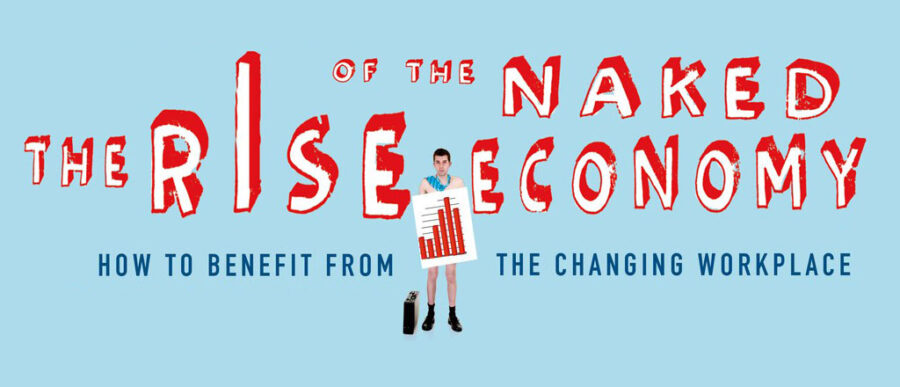In 1989, Scott Adams began publishing Dilbert, a comic strip that first focused on the title character’s life at home but soon moved to the workplace. It was there that it found its groove and came to capture something essential about life in late 20th-century America.
With a light deadpan touch, Adams critiqued the inanity of a drone worker negotiating his way through a micromanaged corporate maze. Adams singled out the omnipresent office cubicle as a symbol of the disconnection and absurdity of contemporary corporate culture, and over the years, the titles of his collections have reflected that obsession: Journey to Cubeville, Another Day in Cubicle Paradise, Dispatches from Cubicleland. His comics eventually became a common presence in the very cubicles they satirized and made several appearances on the cover of Forbes magazine. In 2001, the design company IDEO even collaborated with Adams on the creation of Dilbert’s Ultimate Cubicle.
Yet even as the comic strip was achieving its peak of popularity, the actual nature of work was undergoing the initial stages of a seismic shift that threatens to make Dilbert’s cubicle an outdated relic. Increasingly, a stable (if at times unsatisfying) career working for one company is being replaced by a more volatile and unpredictable reality: In 2010, the U.S. Bureau of Labor Statistics reported that the average time spent at a given job had dropped to less than four and a half years. Even more to the point, a growing segment of the workplace is no longer tied to a single, full-time employer. As many as 30% of those in today’s job market are either self-employed or part-time, and the nation’s largest companies report that 30% of their procurement dollars are spent on contingent or “fractional” workers.
Understandably, these changes are being met with a certain degree of anxiety over legitimate concerns about job security and benefits such as health insurance. But in their new book, The Rise of the Naked Economy: How to Benefit from the Changing Workplace, Ryan Coonerty and Jeremy Neuner make a spirited and compelling case that the new reality has a serious upside. If embraced and correctly harnessed, they argue, the forces reshaping the nature of work can result in “more productive, happier, and sustainable lives.”
No More Gold Watches
The gold watch presented to the worker of an earlier generation upon his retirement came to symbolize a social contract that defined working life for many in the 20th century. In return for job security and a defined set of benefits, employees declared loyalty and ceded considerable control to a corporate employer. A brand of welfare capitalism had been forged out of the strife that characterized the early years of the Industrial Revolution as a kind of peace treaty between capital and labor. The concessions on both sides were substantial. Corporations made accommodations with unions and government regulations, while the workforce gave up the Jeffersonian ideal of the independent yeoman farmer. The unit of organization at the center of this social contract was no longer the independent shop or the family farm, but The Company.
We can no longer afford to think of the term “entrepreneur” as belonging to an elite few.
Well before Dilbert was launched, however, the foundations for that contract were slowly but surely coming undone, for a number of reasons that includes technological change, global competition and the emergence of a knowledge-based economy. Except at the very top of the income scale, American wages have been flat since the late 1970s. Companies looking to cut costs and gain an edge in the brave new world of the global economy replaced the “defined benefit” (DB) pensions of an earlier generation with “defined contribution” (DC) retirement plans that essentially transferred risk from the company to the worker. From 1980 to 2008 the percentage of workers participating in DB plans fell from 38% to 20%, while that of those in DC plans rose from 8% to 31%.
The 2008 Wall Street crash further eroded corporate America’s commitment to a traditional benefits package. A key way to avoid paying benefits has been a growing dependence on temporary workers: Between 2009 and 2012 alone, the number of temporary employees shot up 29%. Overseas outsourcing has become an inescapable reality. In 2011, President Obama asked Steve Jobs if Apple’s products could somehow be manufactured in the United States. His reply: “Those jobs aren’t coming back.”
Though the demise of the 20th century social contract might seem like the unraveling of a long-established way of life, Coonerty and Neuner offer a needed reminder that “the trappings (and the traps) of modern work have been with us for less than 100 years — a mere blip in human history.” They contend that we can no longer afford to think of the term “entrepreneur” as belonging to an elite few, and that the idea of workers acting as independent agents is, in a sense, a return to the old Jeffersonian ideal. “Right before our eyes, Jefferson’s yeoman farmer is reasserting himself, except not as a farmer. The fields we will till, under new social contracts, are virtual, global, and democratic.”
The authors go on to insist that we shouldn’t linger to mourn the old contract, which had its merits but also its shortcomings. The established way of business didn’t factor in environmental costs or the depletion of natural resources. Consumerism and undue corporate influence have at times adversely affected our culture and politics. Corporate America has consistently undervalued the work of women. And, as the sense of alienation so effectively captured by Dilbert has increasingly taken hold, the old model has simply resulted in an underutilization of potential talent and initiative. Coonerty and Neuner cite a recent Gallup poll finding that 53% of the American workforce is not engaged in their work — while 19% are “actively disengaged.”
Yet even while the terms of the old social contract are being redefined or jettisoned altogether, it continues to define our social, political and cultural infrastructure. “How we work, where we live, what we eat, how we educate our children, how we spend our free time, and how we measure the health and success of our economy have all been tailored to serve the interests and metrics of the mythical company of our grandparents,” the authors note.
Despite the very real sense of dislocation and uncertainty brought on by recent changes, the authors see an abundance of opportunity in the new economy, and a good deal of their optimism springs from what they see as a fundamental shift in attitudes toward work, particularly on the part of the new generation known as “millennials” (or Generation Y). In response both to the new economic realities and to a markedly different upbringing defined by social media, among other things, millennials bring a new set of expectations to the workplace. They are less likely to settle for working in a cubicle 40 hours a week, and more likely to place fulfillment and flexibility over job security. They argue that many so-called baby boomers have also come to the same conclusions after years of going about things the old way.
From Cubicles to Coworking
In his 2001 book Free Agent Nation, Daniel Pink predicted that the emerging economy would be organized around project-based teams rather than fixed workplaces. A good example, he wrote, was the way movies are created. An ad hoc team of actors, directors and dozens or even hundreds of specialists quickly assembles, shoots the film over a number of months and then breaks up, each moving on to the next project. Similarly, Harvard Business School professor Amy Edmondson uses the analogy of a pick-up basketball game to define what she calls “teaming”: bringing together a team of professionals for a specific task. What is essentially happening here, Coonerty and Neuner argue, is a reprogramming of what it means to be a company.
The old cubicle-based, static company is increasingly being replaced by a more fluid and mobile model: “the constant assembly, disassembly, and reassembly of people, talent, and ideas around a range of challenges and opportunities.” The traditional office building is ill-equipped to host this new breed of company. And though more and more workers, especially freelancers, are operating from home, the authors believe strongly in the value of face-to-face interaction. Therefore, the new economy and its “seminomadic workforce” will require “new places to gather, work, live, and interact.”
In 2008, Coonerty was the mayor of Santa Cruz, Calif., and Neuner was the economic development manager. Looking for innovative ways to stimulate the local economy, they were struck by the number of entrepreneurs and freelancers working at coffee shops in the area, and they decided to create a workspace that would offer those same advantages in a more structured way. Their joint enterprise, NextSpace, became their first venture into what they call “coworking,” or the creation of “shared collaborative workspaces.”
The basic idea was to “flip our economic model on its outdated head: Instead of attracting one 200-person company to Santa Cruz, we would create a space for 200 one-person companies.” The central mission of NextSpace is to provide members with a flexible infrastructure that allows them to work individually and as teams, and also nurtures what the authors call “managed serendipity” — ad hoc collaboration between people with diverging but complementary skills. For example, an early NextSpace success was the creation of a new smartphone app called Fuel4Humans, a joint effort of a nutritionist, a computer scientist and a graphic designer.
The new economy and its “seminomadic workforce” will require “new places to gather, work, live, and interact.”
Though still accounting for only a small slice of the economy, coworking is clearly on the rise. A survey conducted by Deskmag, an online magazine devoted to the new model, found that the number of coworking spaces worldwide has shot up from 30 in 2006 to 1,130 in 2011 (and was projected to be double that in 2012). Meanwhile, because modern technology has allowed workers to become increasingly mobile, they are bucking the constraints of the traditional workspace: One survey has found that the typical office space is empty for two-thirds of the average workday. Forward-thinking companies are recognizing this reality and responding accordingly. The consumer electronics company Plantronics, for example, knowing that on any given day 40% of its workforce will be working elsewhere, designed its corporate campus to only 60% capacity. And, in contrast to the old cubicle model, its workspaces are designed on a flexible, on-demand and as-needed basis.
Super Specialists and Smart Generalists
Early on in their NextSpace experiment, Coonerty and Neuner found that the most productive collaborations tended to pair highly specialized experts with big-picture thinkers. It has long been a truism that the knowledge-based economy favors increasing specialization, and the authors agree with that, up to a point. Specialization has grown even more narrow, more defined, producing what two MIT management professors term “The Age of Hyperspecialization.” This has produced a new market dynamic in which the headhunter of yesteryear has been replaced by “talent brokers” who connect highly specialized talent with companies on a project-by-project basis. Firms like Business Talent Group (which, though founded in 2007 already has offices in New York, Los Angeles, San Francisco and Austin) have found the new model a win-win for everyone. Clients get the specialized help they need at a cost below that of a full-time employee or traditional consulting firm, and specialists are well compensated and rewarded with flexible schedules and a greater degree of choice about which projects to take.
On the other hand, Coonerty and Neuner themselves are proud generalists and firm believers that generalists (and the traditional liberal arts education that produces them) tend to be undervalued. It’s easier to measure the results of specialists, but someone needs to keep an eye on the big picture, to “connect the dots.” Citing the work of a number of thinkers and researchers, the authors argue that the need for smart generalists is only growing. As computers have taken over many rote tasks — and as the “individual, linear, procedural” work the cubicle model was built for is increasingly outsourced — the work that remains is “largely creative and conceptual” and team-oriented, all strengths of the smart generalist.
The Naked Economy isn’t just about ad hoc project-based teams, freelancers and specialized consultants. Progressive, forward-thinking companies will incorporate the new ethos into a fresh way of doing business, and the authors cite several companies that are at the forefront of this effort. One is Automattic, a San Francisco-based company best known for developing the open-source blogging platform WordPress. On the one hand, the company embraces what the authors call the “disaggregated workforce model.” Its founder, Matthew Mullenweg, doesn’t have much faith in traditional office buildings or corporate campuses: “I would argue that most offices are full of people not working.” Accordingly, Automattic’s workforce is far-flung: two-thirds of its employees are in various U.S. locations, while the remainder lives in 90 cities in 24 countries. On the other hand, Mullenweg is a big believer in face-to-face collaboration and brainstorming, and flies his teams all over the globe to do so. He also set up an informal workspace in San Francisco called the Lounge. Located in a former restaurant, the Lounge is basically just a bunch of couches and tables, no computers. “Thus,” the authors note wryly, “Automattic might be the first tech company to have a techless headquarters.”
An early NextSpace success was a new smartphone app called Fuel4Humans, a joint effort of a nutritionist, a computer scientist and a graphic designer.
The craft-beer company New Belgium Brewing, best known for its flagship product Fat Tire Amber Ale, is another example. New Belgium has in other ways absorbed the more fluid and collaborative spirit of the new economy. In addition to a set of generous and unusual perks, the company practices “open-book management” — providing all employees with access to its finances. From the start, the Brewery had incorporated a number of environmentally green practices. In 1998, the company’s cofounder presented the employees with a plan to convert entirely to wind power. Though there would be numerous long-term benefits, the employees would have to sacrifice their bonuses for several years in order to finance the conversion. The vote was a unanimous thumbs-up. At the beginning of 2013, New Belgium implemented an Employee Stock Option Plan and is now 100% employee-owned.
Not a Seamless Transition
Coonerty and Neuner are unapologetic champions of the promise of the new economy taking shape before our eyes, but they acknowledge there will be winners and losers, as well as considerable dislocation along the way. They also concede that not everyone will be committed to creating sustainable, connected lives for workers, and that in the face of intense global competition, we must guard against what one study calls “digital sweatshops.” Social networking tools alone will not make us feel more connected, and in some cases may do the opposite.
Moreover, they point to several public policy challenges that will have to be tackled in coming years. These include a health care system that to date has largely been predicated on employer-based health insurance coverage. The coming implementation of Obamacare will expand the range of options, but the challenge for freelancers and independent contractors will remain. Additionally, a 2010 Kauffman-Rand study worried that employer-based health insurance, by discouraging risk-taking, will be an ongoing drag on entrepreneurship. The authors also raise the problem of payroll taxes for freelancers — which, unlike in the case of employees working a so-called “real job,” are not shared with an employer. Finally, according to a survey by the Freelancers Union, up to 44% of independent workers encounter difficulty getting paid fully for their work.
Yet Coonerty and Neuner remain optimistic that the Naked Economy — by stripping work bare of all the “trappings, tools, and technologies that we’ve clothed it in” — presents us as a society, and as individual workers, with a unique opportunity to align economic and human development in a new way, creating “the possibility of making a living while also making a life.”



